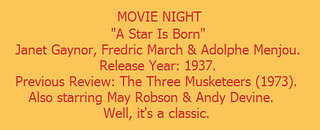

Review #973: A Star Is Born.
Cast:
Janet Gaynor (Esther Blodgett/Vicki Lester), Fredric March (Norman Maine), Adolphe Menjou (Oliver Niles), May Robson (Grandmother Lettie), Andy Devine (Daniel "Danny" McGuire), Lionel Stander (Matt Libby), Owen Moore (Casey Burke), Peggy Wood (Miss Phillips), Elizabeth Jenns (Anita Regis), Edgar Kennedy (Pop Randall), and J. C. Nugent (Mr. Blodgett) Directed by William A. Wellman (#349 - Wings, #494 - The Public Enemy, and #866 - Nothing Sacred)
Review:
A Star Is Born is certainly a interesting film about the insides of Hollywood (made by people in the system), with a fair amount of melodrama and good performances all around. A Star Is Born is a neat flick that has had the fortune of being remade three times (1954 and 1976, with one coming out in 2018), but this one and its legacy cannot be understated; the fact that the film is in the public domain and is readily available doesn't hurt either. Gaynor has a fine capable charm to her that makes it easy to follow along with her on her path, and she even makes some neat impersonations of actors of the time. March does a fine job as well, portraying his self -destructive arc quite capably that fits in line with the tone of the film. They have a fine amount of chemistry together, seeming quite at ease with each other, with their last scene being quite fitting. Menjou is fairly interesting, making a decent and convincing impression. Robson and her character are quite quirky along with being useful to the film for the most part. Devine and his distinct raspy voice make for a fine side role that makes for some amusement. Stander does a fine job, showing the smarmy nature of his character that comes off as convincing along with helping to giving the film an edge of cynicism. It's not a film mired in optimism (nor pessimism), as it's a film that wants to show the glow along with the drama that goes on with Hollywood, albeit with some inspiration from real life, such as the marriage of Barbara Stanwyck and Frank Fay, though the film has some similarity to What Price Hollywood? (1932), and the studio that had made that film (RKO) had thought about suing Selznick International Pictures (the production company for this film) for plagiarism but had decided against it.
The cinematography by W. Howard Greene is quite nice, showcasing a fair amount of color that certainly stood out for the time. He was given an honorary Academy Award for his color photography on the film (fun fact: from 1936 to 1938, Special Achievement Academy Awards were given for color films, and from 1939-1967 (except for 1957), there were separate awards for black-and-white and color cinematography). This won the Academy Award for Best Writing (Original Story, which is now known as Best Original Screenplay), and it's not hard to see why. It has its heart and mind in the right place while running at a smooth pace of 110 minutes that doesn't have a minute of false nature to it.
Overall, I give it 9 out of 10 stars.

No comments:
Post a Comment